
As we get older, we may notice changes in our mobility and sensory experiences, such as not seeing as well or as easily as we did in our younger days
Age may not be so kind to us
As we get older, many things happen gradually. We may notice some aches and pains that weren’t there the day before. We may notice some issues with vision, hearing, or balance that we hadn’t really noticed or paid attention to previously.
When we discuss home modifications for aging in place, we look at many aspects of a person’s home and their ability to be in that space effectively – including accessibility. However, many issues in the home environment concerning how well someone can experience their living area are tied to physical changes we experience. Often we discuss someone’s changes in mobility such as how they might be able to grasp an object, walk up steps, or navigate doorways as something that has an immediate onset – yesterday a person was not experiencing any such limitations and today they are.
While this can happen overnight, it more often it is a gradual progression. Someone in their 30s or 40s or 50s might have a certain level of experience in terms of what they can see, what they can hear, or how they move their joints. As they get into their 60s and later in life, that experience changes. It wasn’t an overnight sensation it was gradual.
Life sneaks up on us
Life has a way of sneaking up on us. For the longest time, we took life as it came, with and limitations being temporary and dealt with while they lasted. As we get older, they don’t disappear as readily or at all.
Therefore, understanding that people’s needs change little-by-little over time and that not everyone has the same experience but likely will encounter some of these mobility and sensory changes in their lives, we can design their home environments to take these into account
Addressing changes that come with aging
The more we can create passageways that are accessible, flooring that is non-slippery, lighting that illuminates all surfaces without any resulting glare, the more we will have addressed changes that are happening with mobility. Where possible, we can include redundant notifications or alerts to notify people through multiple sensory experiences what is happening. Generally, this is nothing more than a visual and audio clue attached to the same item such as an electronic doorbell, a dishwasher, a washing machine, or some other fixture, appliance, hot water faucet, or some other device to let us know through more than one sense what is occurring.
When we can see a visual notification and we can hear an audio response, we have more opportunities to know what is going on – miss one and we have the other to alert us. If we hear and see both that’s fine as well. Sometimes, there are even more than two notifications.
The main thing to remember is that sensory changes generally are not sudden onset. They can be, but for our aging in place design considerations, let’s count on people changing gradually over time and make our design recommendations on that basis. Their vision may be fine today but not as strong a year, two years, or ten years from now. Their balance may be OK today, their hearing may be OK today, and they have encountered any type of injury or traumatic event that would have changed that, but just normal the normal aging process will lessen the sharpness of those senses. The same can be true with touch, range of motion, and reaching and grasping.
There’s no escaping the aging process
Aging happens. There is no getting around it. However, people experience changes in their abilities in different ways and at various times in their life. At age 50, not everyone will have the same vision or hearing decreases from earlier in their lives, but these are likely to happen at some poin. While not everyone will experience cataracts, many people do. Nearly everyone experiences some presbyopia which is the inability to see fine print without the aid of reading glasses or cheaters. People have depth perception or figure-ground issues as they age – again some more pronounced than others
If someone is not presenting a particular need in terms of lower or decreasing vision or decreased hearing it doesn’t mean that they have passed that point in life and will never experience it – such as being past the point of contracting a childhood illness and not needing to be concerned about that any longer. It just means that it hasn’t happened with them yet, and some people will be more severly impacted than others..
